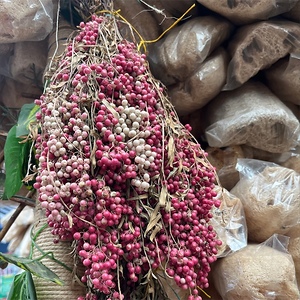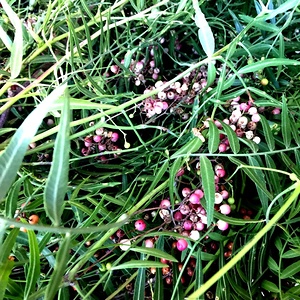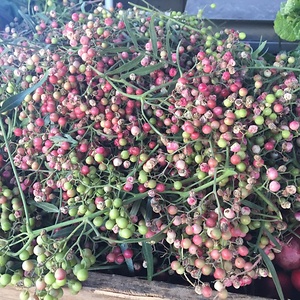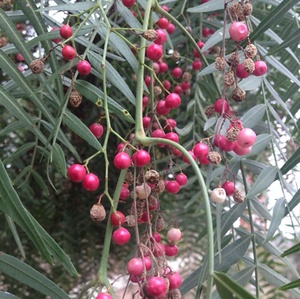

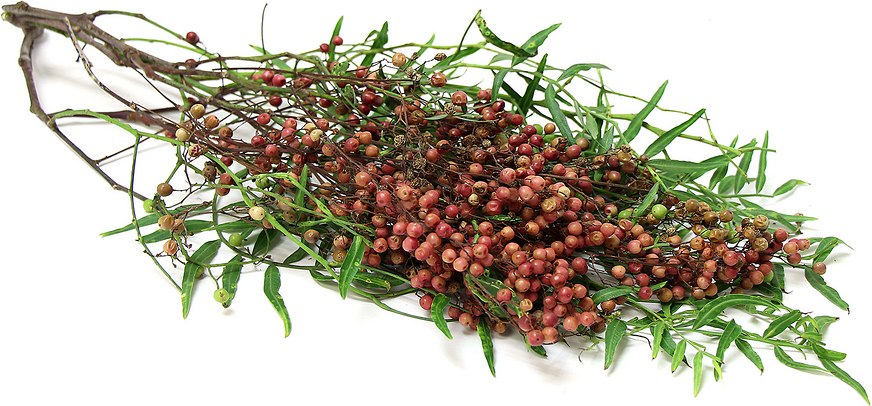
Pink Peppercorns
Estimated Inventory, lb : 0
Description/Taste
Pink peppercorns are small, round, and similar in size to black and white peppercorns. Each peppercorn measures approximately 4 to 5 millimeters in diameter. This size renders them somewhat fragile, allowing them to be easily crushed between fingers. Their color ranges from a pale pink to a deep reddish pink, and they are sometimes speckled with darker spots. In contrast to the hard, wrinkled shell of black and white peppercorns, Pink peppercorns have a smoother, shinier husk. Inside, they house a tiny beige seed that is soft and easily crushable. Aromatically, Pink peppercorns exude a sweet, berry-like fruity scent with occasional zesty citrus and pine undertones. Flavor-wise, they mirror their aroma, offering similar berry-like notes along with a mildly spicy and slightly resinous taste.
Seasons/Availability
Pink peppercorn is harvested in late summer or early fall.
Current Facts
Pink peppercorns, botanically classified as Schinus terebinthifolius, originate from South America. Despite their name, they are not true peppercorns but rather the berries of the Brazilian and Peruvian pepper trees, also commonly referred to as the Christmas Berry tree. Pink peppercorns are used for many culinary purposes, often found in spice rubs for meat, poultry, and fish. They also have a diverse range of practical purposes across various countries. In Mexico, they are used to create a fermented drink known as capalocle, while in Ethiopia, they serve as a natural repellent for houseflies. Pink peppercorns were once a localized foraged good, but over time, they became an important culinary, medicinal, and cultural plant utilized fresh and dried.
Nutritional Value
Pink peppercorns contain vitamin A, which is vital for vision, skin health, and immune function. They also have a small presence of vitamin E, known for its antioxidant properties that help protect cells from oxidative stress. Pink peppercorns are enriched with antioxidants like anthocyanins, gallic acid, and bioflavonoids. These compounds may provide anti-inflammatory effects, cell damage protection, muscle swelling relief, and cramp prevention. However, due to the small quantities typically consumed, their overall impact is likely to be minimal. Numerous cultures value Pink peppercorns for their potential medicinal properties, considering them as remedies for ailments like bronchitis, tuberculosis, and gingivitis. Pink peppercorns are also rich in compounds such as pinene, limonene, phellandrene, and carene, which are highly volatile and prone to evaporation and oxidation when exposed to air, light, and heat. This volatility plays a significant role in the inherent fragility of Pink peppercorns.
Applications
Pink peppercorns can be eaten raw, dried, or cooked in a wide array of savory and sweet dishes. When used raw, they add flavor to salads, cheeses, or seafood, ideally sprinkled just before serving. The dried form, commonly found in stores, can be either crushed or added whole to enhance dishes like fish, poultry, stir-fries, and vegetables. When cooked, Pink peppercorns blend well into sauces, marinades, and meat preparations. Major producers of Pink peppercorns include Madagascar, Brazil, Peru, and Reunion Island, but they have gained significant popularity in France, where they are known as 'rose-poivre' and featured in dishes such as côte de boeuf with Pink Peppercorn sauce. They pair well with flavors in the same aromatic sphere, such as juniper berries, cinnamon, sesame, coriander, saffron, ginger, mint, rosemary, and basil. Complementary ingredients include citrus fruits, cardamom, vanilla, strawberries, pineapple, lavender, pomegranate, lemongrass, beef, chicken, and white-fleshed fish. Pink peppercorns should be stored in an airtight container and placed in a cool, dark area for optimal freshness.
Ethnic/Cultural Info
Archaeological evidence reveals that there were gatherings formed around harvesting Pink peppercorn berries in the ancient Peruvian Wari Empire, which predated the Incas. The berries of the Pink peppercorn tree, as well as its leaves, bark, and roots, were processed into yellow dye, employed in embalming, and used to start fires. The primary application of the berries was in brewing chicha de molle, a fermented drink similar to beer. During the 1960s and 1970s, Pink peppercorns gained culinary fame with the rise of French nouvelle cuisine. This innovative cooking style emphasized delicate, artfully presented dishes, often featuring Pink peppercorns.
Geography/History
Pink peppercorns continue to grow abundantly in their native home of South America. While they thrive in hot and wet climates, Pink peppercorn trees can grow in a variety of conditions. The tree is drought-resistant and evergreen, allowing it to be cultivated in many warm regions across the globe, including parts of Africa, India, Australia, and New Zealand. Pink peppercorn trees were introduced to Florida in the 19th century and have adapted often too well in several other states, including Arizona, California, Hawaii, Louisiana, Puerto Rico, and Texas, leading to their classification as an invasive species in some areas. This invasive status is mainly due to its prolific nature and the tree's capacity to outcompete native vegetation. Pink peppercorns thrive in diverse environments, including wild, natural areas, as well as in controlled domestic and commercial settings. These peppercorns are typically sold whole and dried to preserve their flavor and aroma. While you might find Pink peppercorns in local grocery stores, they are more commonly available in international markets. Their presence in stores can vary based on location and the store's emphasis on international or gourmet food selections.
Recipe Ideas
Recipes that include Pink Peppercorns. One



